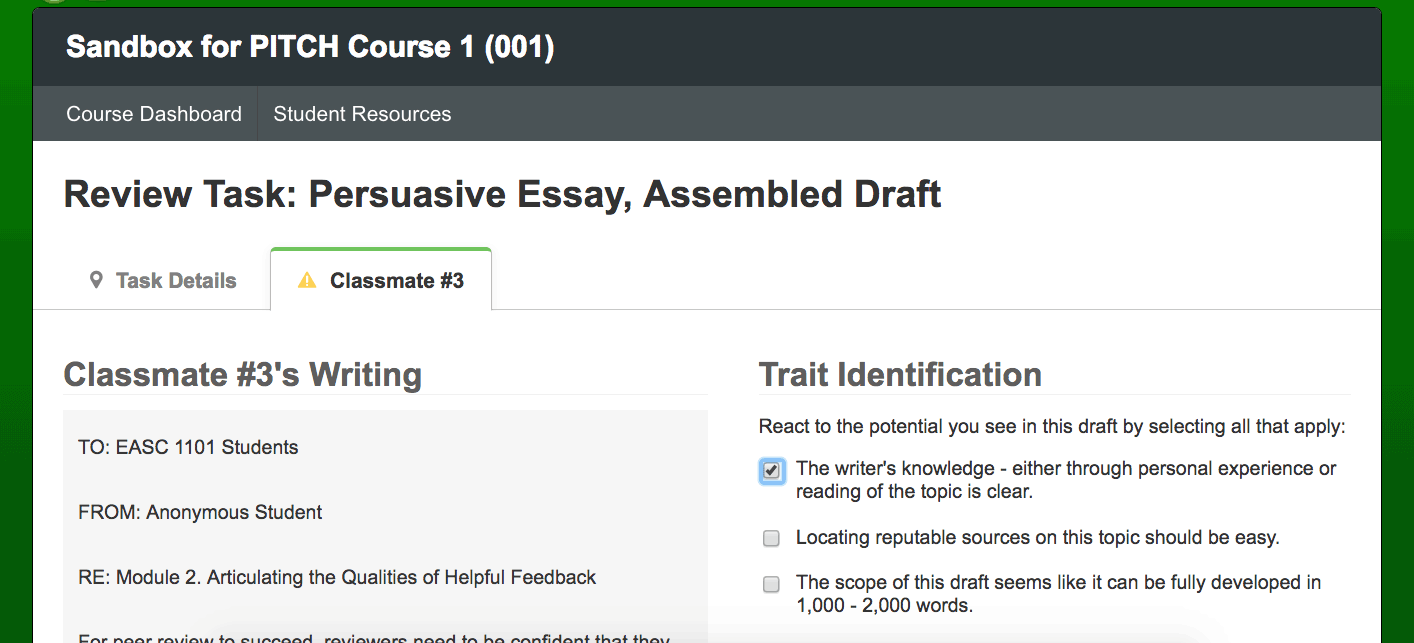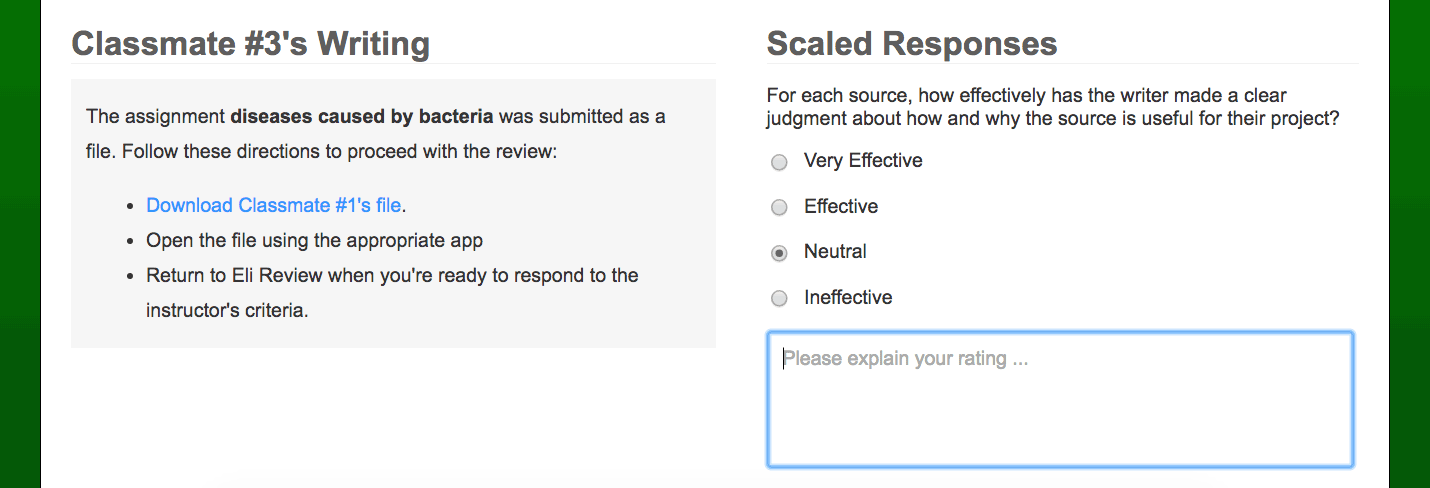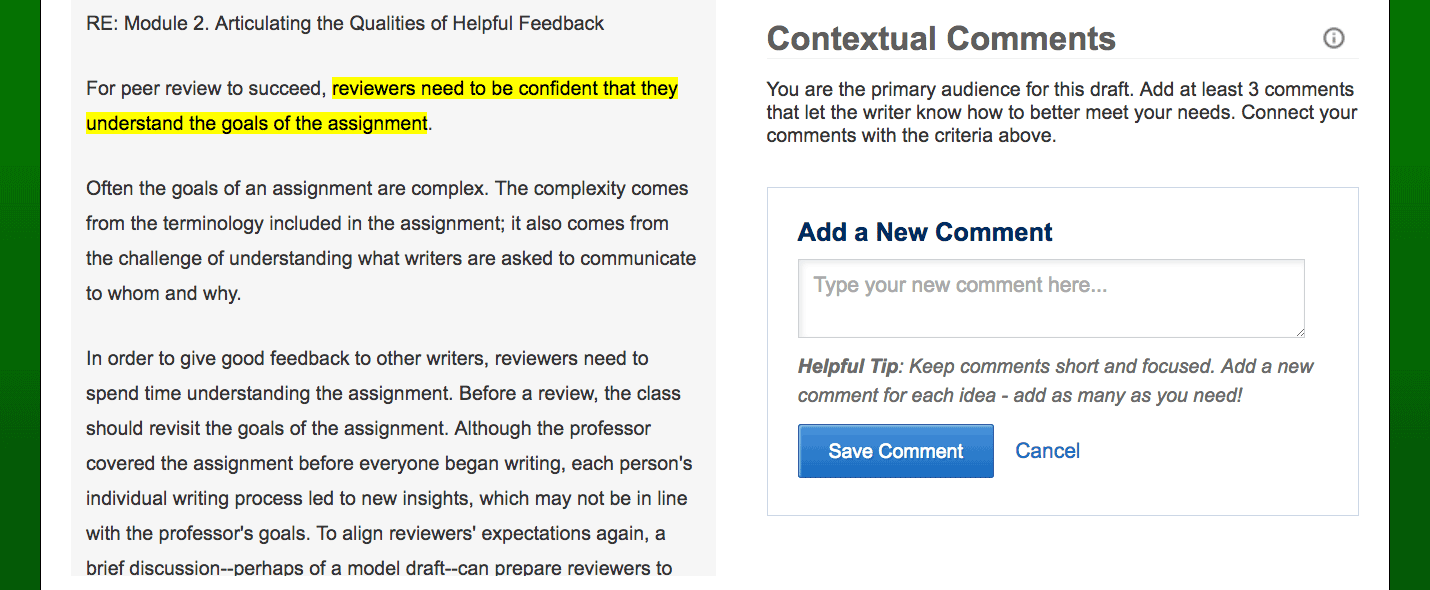Eli Review is designed not only to help you improve your writing but also the feedback you give others.
Giving helpful feedback is an important skill in school and in the workplace. Bill Hart-Davidson, one of Eli Review’s inventors, tells his students: “The best leaders give the best feedback.” Eli gives you the tools to practice being a helpful reviewer.
Giving helpful feedback also drives your own improvement as a writer. Hart-Davidson calls it giver’s gain.
Giving feedback in Eli occurs during a review task. Like a survey, a review is designed by an instructor to guide you in reading and responding to your peers’ writing. Most reviews have two parts:
For specific details about how to complete review tasks in the app, check out the video and screenshots in Eli’s student user guide. The resources there explain how you can complete checklists, offer ratings, add contextual comments (comments that might connect to a highlighted passage in a draft), and add a final comment.
This tutorial offers strategies for what you should be thinking about while answering questions and adding comments in reviews. Example comments are included to help you put it together.
Instructors design reviews so that the questions help students compare the draft to the criteria for the assignment. Questions take two basic forms: checklists and ratings.
One common question type is a trait identification checklist. If the draft fits the description, tick the checkbox. If not, leave it blank. The essay clearly contains the writer’s knowledge through experience about the topic is clear, so that box is checked. But, the essay topic makes it difficult to locate reputable sources, so that box is not checked.

These checklists usually emphasize the most important criteria for successfully completing the writing task, so be sure to focus on these expectations. In particular, try to refer to these criteria in your comments in that later section of the review.
As you review the feedback you have received from others, items on the checklist that are missing may be important revision priorities for you.
Some reviews may also include ratings. After you’ve checked to be sure a draft has the most important criteria, you are better prepared to say how well that draft meets the goals.
You might be asked to evaluate the draft using a star rating or a Likert scale. For both types of ratings, you might also be asked to explain your choice. By telling writers why you rated them at a certain level, you will help them gauge how much revision they need to do.
In the first image below, the reviewer selects “3 stars” because the draft includes contrastive details, but the amount and kind of contrastive detail doesn’t stand out, so a higher rating isn’t appropriate.

In the image below, the reviewer chose “neutral” because the writer includes an annotation about each source but doesn’t take a stand about why or how that source contributes to the project.

Rating drafts might feel uncomfortable. If you struggle choosing the number of stars or the best description in a Likert scale, try predicting what your instructor would rate it. For example, here’s how an Eli instructor who taught at West Point made that that responsibility clear for cadets:
Likert scale (choose one), prompt: Predict how Major Johnston will assess this paper after reading 58 others like it.
- A. It is unique, clean, and on-the-prompt.
- B. It is a skillful response to the prompt, but there are issues.
- C. Nothing special. But it somehow deals with the prompt.
Be sure to respond to all of the questions your instructor asks in the review to the best of your ability. Reviews are designed to help writers improve their drafts. Your careful and honest feedback on checklists and ratings about how successful the current draft is could be the inspiration writers need to radically change their drafts before submitting to your instructor for grading.
Comments are probably the most common form of review feedback. While other review features ask you to tick a box or choose a rating, comments allow you to communicate with writers. Comments are connected with several aspects of Eli’s approach:
Reviews include two types of comments:
For each type of comment, instructors provide a prompt or a set of instructions for how to comment on the drafts. Be sure to read the instructions before you start adding comments to make sure your focus matches your instructor’s goals for this stage of the writing process.
Contextual comments work like comments in Microsoft Word when drafts are typed/pasted in Eli. By first highlighting the passage and then choosing “Add Comment,” writers will be able to see exactly where in their writing your comment applies. The image below shows the highlighted passage in the writer’s draft on the left; on the right, reviewers can type their comments in Eli.

If drafts are uploaded to Eli or if you don’t want to tie your comment to a specific passage, you can also add comments without highlighting. Just click “Add Comment” and compose your response.
The final comment gives you a single space to compose feedback. Instructors might ask you to respond to the draft as a whole or may pose several questions. Unlike contextual comments, you can only add one final comment and you cannot tie it to a highlighted passage in the draft. You can, however, use words to describe where your comments apply such as “in the second paragraph” or “right after the quote from the book.”
Here’s a brief tutorial on how to make contextual comments in Eli:
Instructors often provide instructions about the kinds of comments you should offer your peers, so be sure to read those before you start adding comments. Also, look back over the trait identification checklists at the start of the review and try to connect your comments with those criteria.
As you follow your instructor’s guidance about what to comment on, try to follow the three part pattern explained by Bill Hart-Davidson in “Feedback and Improvement”:
Here you can watch Bill Hart-Davidson, one of Eli Review’s creators, explain describe-evaluate-suggest:
In the sections below, we offer a rationale for each part of the pattern and several templates you might use.
As a reviewer, your interpretation of what the writer is trying to do is essential. If your interpretation matches writers’ goals, then writers can be confident that they communicated well; if your interpretation does not match writers’ goals, then writers need to revise.
Renowned writing teachers Peter Elbow and Pat Belanoff in their book Sharing and Responding called this step “say back”:
“Please say back to me in your own words what you hear me getting at in my piece, but say it in a somewhat questioning or tentative way–as an invitation for me to reply with my own restatement of what you’ve said.” (Elbow and Belanoff cited in “Peer Response” by “Peer Response” by University of Massachusetts Amherst Writing Program)
When you “say back” in your own words what the draft is saying, you help writers better understand how to connect with you and their broader audience.
Here are some sample sentence starters you can use when describing a draft:
Notice that many of these sentence starters might lead to praise rather than criticism. That’s great! Writers need to know why reviewers say “good job” just as much as they need to know why reviewers say “change this.” A good description of what the writer has accomplished makes a praise comment helpful because such comments tell writers what to keep doing next time.
Like with the rating questions above, this part of a comment tells writers how well they are achieving a specific goal. Because this evaluation follows your description of the draft, writers should understand that your critique is about the draft, not about them personally. Still, getting an evaluation always feels personal, so be respectful.
If your instructor has included ratings or uses a rubric, include the scales in your comments. For example, a rating scale might range from “not very effective” to “highly effective”; a rubric might range from “below expectations” to “exceed expectations.” Use those words in your evaluation.
If you don’t have a rating or rubric to lean on, consider where the draft fall between these descriptive pairs:
In a positive evaluation, your comments tell writers what they should keep doing. In a critique, your comments tell writers what needs to change.
It’s also good to keep in mind that a general statement, even a positive one, can be less valuable. Simply saying “good job!” without explaining what you mean may not have the effect of making the writer feel good about their work.
In the final part of a comment, offer the writer a way to revise. Try to give feedback about what to try next instead of saying how to fix the problems. Consider these examples:
Feedback that fixes limits writers’ decision-making, and your goal as a reviewer is to help writers have a better sense of their options and next steps. You can do this even when you are commenting on a positive feature, letting the writer know what they can do again next time.
Because options and next steps are critical for writers, ending your comment with a good question is one of the most helpful things you can do. Your question sends writers to find their own answers, and that discovery process is important for improving their writing.
Here are some question starters that you can use as suggestions:
Offering helpful feedback about next steps is hard to do for peers (and instructors), so be patient with yourself as you learn to offer good suggestions.
Comments written according to the describe-evaluate-suggest pattern have the information writers need to revise. These comments tend to make sense even if readers do not have access to the original draft or the original assignment. Because reviewers have said what the draft is doing, how well it is meeting the criteria, and what steps are needed to improve, writers can follow reviewers’ thinking. Writers are likely to trust that reviewers have read their drafts well, and they have the information they need to revise.
In the following comment, try to label where the reviewer describes, evaluates, and suggests:
Now, reread the comment and answer these questions:
If you answered “yes” to all of these questions, then you agree with us that this is at least a “three star” comment in terms of its helpfulness. Here’s how our team answers these questions about the sample comment above:
Writers rate the helpfulness of comments, but, as reviewers, using these questions can help you proofread your comment before you send it back to writers. Wait? Proofread a comment? Yes. Remember that the the best leaders give the best feedback, so make sure your comment is as clear as possible.
For each comment below, practice rating the helpfulness of the comment using these questions:
Each “yes” answer is one star; and the fifth star is used only when the comment will help the writer transform the draft.
The data you selected is very good for supporting your argument. I think the clarity of the relationships in ideas could be made more clear by making a statement about why the data contradicts the beliefs of the community. A good opportunity to do this could be in the last sentence.
The first thing I would say is that you need a thesis statement, which could revolved around the idea that your experiences with technology include internet, video games, and cars. I liked the amount of personal experiences that you used as examples. It is especially interesting since I do not get to hear much about the rise of technology in other countries. So take advantage of the stories you have from China, and that can create a really interesting paper that has more of “technological experiences around the world” feel to it than just a personal story. You have a great opportunity to talk not only about your personal experiences with technology, but you can add your observations of technology attitudes and use between China and the US. It would be a great way to give you more to talk about if you are running out of ideas, and a way to compare how you started with technology compared to how you use it now. I would suggest reformatting your paper to follow a specific format than just a list of experiences and their details. You could start with talking about computers and the internet. How it affected you personally as a child compared to your involvement with them now. A great detail to add would be what you already have down: your grandparents’ thoughts and experiences with the same technology. You can even add how society has been adapting to the expansion of technology, just make sure you bring it back to your personal experiences compared to your grandparents’ and society’s experiences. A similar format can be follow for video games and cars, so I will let you explore that idea and expand on it if you want. My question to you would be this: how can you format your paper to best convey your experiences with technology? I understood what you wrote and how you wrote it, but how can you make it flow between a small amount of big ideas compared to a big amount of small ideas.
If you wanted to sandwich the ‘bad news’ in between the ‘good news,’ you could stop the first paragraph after the sentence “provide everything you need and more.’ You could then insert the ‘Due to the cost…$1500.00 per day.’ Then put the ‘enjoy the amenities statement and list after that, letting them know what that low price includes. This may help the customer focus on what they will get and not the price be last thing they focus on.
#grammar You only need to say “you” once in this sentence. Consider “I am sending this letter to introduce myself to you” or “I am sending you this letter to introduce myself.”
Note: This reviewer is following the instructor’s guidelines to begin comments with one of the following hashtags: #content, #org, #style, #grammar. Hashtags catagorize comments, so it is easy to keep see how many of each type of comment is being exchanged. Hashtags help reviewers make sure that most of their comments are about #content and #org rather than about #style and #grammar.
Great work!